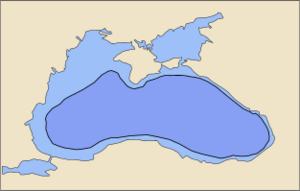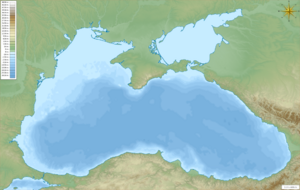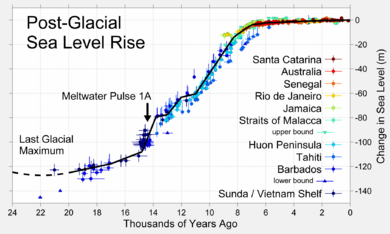Black Sea deluge hypothesis facts for kids
The Black Sea deluge is a big idea about how the Black Sea might have changed a long time ago. It's one of several theories that suggest a huge flood happened in the Black Sea basin after the last Ice Age. This idea suggests that the Black Sea, which was once a freshwater lake, was suddenly filled with salty water from the Mediterranean Sea.
Contents
The Big Flood Idea

In 1997, a group of scientists, including William Ryan and Walter Pitman, shared their idea about the Black Sea flood. They believed that around 7,600 years ago (or about 5600 BCE), a huge amount of salty water from the Mediterranean Sea suddenly poured into the Black Sea. At that time, the Black Sea was a much smaller freshwater lake.
This idea suggests that such a big flood would have greatly changed how people lived in Eastern Europe and parts of Asia. Some people even think this event might be the real story behind the ancient myth of Noah's flood. Some archaeologists agree, saying it could explain why there aren't many ancient villages from the Stone Age in northern Turkey. Later, in 2003, Ryan and his team changed their estimate for the flood to about 8,800 years ago (or about 6800 BCE).
Before this time, huge glaciers were melting. This meltwater had turned the Black Sea and Caspian Sea into very large freshwater lakes. These lakes drained into the Aegean Sea. As the glaciers melted even more, some rivers that flowed into the Black Sea became smaller or changed direction, flowing towards the North Sea instead. This caused the Black Sea lake to shrink due to evaporation. At the same time, global sea levels were rising everywhere.
Eventually, the rising water from the Mediterranean Sea spilled over a rocky barrier, called a sill, at the Bosporus strait. This event, according to the theory, flooded about 100,000 square kilometers (about 38,600 square miles) of land. It also made the Black Sea much bigger, especially to the north and west. These researchers said that about 50 cubic kilometers (12 cubic miles) of water rushed through the Bosporus every day. This is 200 times more water than what flows over Niagara Falls! They believed this massive flow lasted for at least 300 days. They argued that this huge rush of seawater happened because the Laurentide Ice Sheet (a giant glacier) collapsed, and a rock barrier in the Bosporus broke open.
News Stories About the Flood
This idea about the Black Sea flood became very popular. The New York Times wrote about it in 1996, and a book was published later. A team of underwater archaeologists, led by Robert Ballard, explored the Black Sea. They found what looked like old shorelines, shells from freshwater snails, old river valleys, and even wooden tools and structures made by humans. These findings were about 100 meters (330 feet) underwater off the coast of modern Turkey.
Other Ideas About Black Sea Floods
Besides the "Noah's Flood" idea, other scientists have suggested different ways the Black Sea might have changed.
In 2003 and 2007, a scientist named Andrei L. Chepalyga proposed an even older flood. This idea, called the Late Pleistocene Great Flood, suggests that a lake in the Black Sea basin was quickly filled with melting glacier water from the Caspian Sea. This happened through a connection called the Manych-Kerch Spillway, about 17,000 to 14,000 years ago. This huge meltwater flood connected many lakes and seas, creating a "Cascade of Eurasian Basins." This event might have caused the Black Sea level to rise very quickly. It could have put a lot of stress on people living nearby and might even be the origin of the "Great Flood" stories in different cultures. Some also think it might have led to the start of shipping and taming horses.
Another idea is the Black Sea gradual inundation hypothesis. This theory suggests that the Black Sea was filled slowly, not suddenly. Around 8,000 years ago, the level of the Marmara Sea (which connects to the Black Sea) rose enough for water to start flowing both ways. Evidence for this idea includes different ages of mud layers in the Mediterranean and Black Seas, old sand barriers found on the Black Sea floor, and an underwater delta (a fan-shaped deposit of sediment) in the Marmara Sea made of Black Sea dirt.
Why Some Scientists Disagree
Not all scientists agree with the idea of a sudden, huge flood in the Black Sea. Their main questions are about how big and how fast the water level rose. If the changes were more gradual, then the idea of a sudden catastrophe might not be true. Here are some key points:
- Since the last Ice Age ended, the global sea level has risen about 120 meters (390 feet).
- The flood idea depends a lot on how the Bosporus strait looked after the Ice Age. The Black Sea area has been cut off and reconnected to other seas many times over the last 500,000 years.
Those who disagree with the sudden flood idea point to clues that water was actually flowing *out* of the Black Sea basin as recently as 15,000 years ago.
In this different view, the Bosporus strait is very important. A study from 2001 found that the deepest part of the Bosporus is about 32 to 34 meters (105 to 112 feet) below sea level today. It's made of sand over older rock, with three deeper rocky areas about 80 to 85 meters (262 to 279 feet) below sea level. Sediment (dirt and sand) started building up on these deeper parts before 10,000 years ago and continued until 5,300 years ago.
Many geologists also don't believe there was enough constant water pressure from the Aegean Sea to carve through a land bridge at the Bosporus. They also question if there was a big enough difference in water levels between the two seas to cause such a flood.
In 2007, a book was published that brought together a lot of older Russian research with newer scientific findings on this topic.
A 2009 study by Liviu Giosan and his team suggested that the Black Sea level before it reconnected with the Mediterranean was only about 30 meters (98 feet) lower than it is today. This is much less than the 80 meters (262 feet) or more suggested by the catastrophic flood theories. If a flood did happen, the sea level rise and the flooded area would have been much smaller than first thought. Since the Bosporus is currently between 36 and 124 meters (118 and 407 feet) deep (with an average of 65 meters or 213 feet), a Black Sea shoreline only 30 meters lower might mean it was never completely cut off from the Mediterranean during the Holocene period. This would mean there was no sudden "waterfall-style" flood. The flooding might have been "not so big."
In 2011, several scientists concluded that there is "no underwater archaeological evidence" to support a sudden flooding of ancient Black Sea settlements.
A 2012 study, looking at tiny sea creatures called dinoflagellate cysts, also found no evidence for a catastrophic flood. Other scientific evidence from geophysics, dating methods, and geochemical studies suggests a "fast transgression" (a quick rise in sea level) that lasted between 10 and 200 years, rather than a sudden, one-time event.
A review of scientific papers in 2022 concluded that there wasn't enough evidence for a sudden flood. It seemed more likely that the Black Sea's waters gradually flowed out to the Mediterranean. Also, there was no archaeological evidence that people left the area suddenly during that time.
See also
- Black Sea undersea river
- Altai flood
- Flood myth
- Noah's Ark
- 4.2 kiloyear event
- 5.9 kiloyear event
- 8.2 kiloyear event
- West Siberian Glacial Lake
- Zanclean flood, a flood that filled the Mediterranean Sea



